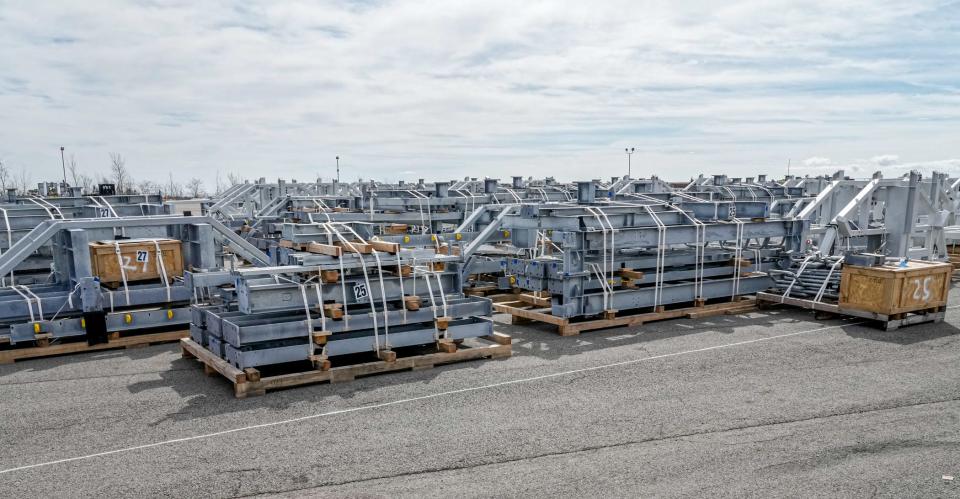Work has started on major offshore wind farm that would power Rhode Island. What to know.
PROVIDENCE – The developers of Rhode Island's first utility-scale offshore wind farm are still waiting on approvals for the 704-megawatt project, but that’s not stopping them from starting work on pieces of it.
Ørsted and Eversource welcomed Gov. Dan McKee, the Rhode Island congressional delegation and other officials to the Port of Providence on Monday to mark the beginning of fabrication of some of the key components of the towering wind turbines that will be installed in the waters between Block Island and Martha’s Vineyard as part of Revolution Wind.
The companies set up shop a year and a half ago in the port, where they built a regional hub that is supplying parts to a host of wind farms planned off southern New England.
More about offshore wind in RI: Rhode Island is playing a key role in a pivotal year for offshore wind in America

'Jobs of the 21st century'
First up for the facility was the South Fork Wind Farm, a 130-megawatt, 12-turbine array already under construction that will help power Long Island. Now comes Revolution, the 65-turbine project that would deliver energy to Rhode Island and Connecticut. Sunrise Wind, an 880-megawatt proposal to also supply New York, is expected to follow. And, if all goes as planned, a second, even bigger phase of Revolution would come.
It’s all part of a long-term vision to not only generate cleaner sources of power to help meet the nation’s climate goals, but also position Rhode Island as a manufacturing base for offshore wind development.
“These are jobs of the 21st century and beyond,” said McKee. “And we’re lucky to be at the forefront of this revolution.”
The groundwork for the manufacturing center at ProvPort was laid more than 15 years ago when Rhode Island policymakers started looking at offshore wind as a potential source of renewable energy. The state selected Deepwater Wind to build a 30-megawatt test project off Block Island that in 2016 became the first offshore wind farm in America.
Deepwater, a Providence-based startup, staged part of the five-turbine project from the port. After Ørsted, the Danish developer that bought Deepwater, partnered with New England utility Eversource to build a series of much larger wind farms, they committed to becoming a permanent presence there.

They’ve invested $100 million so far, according to company executives. They put up a cavernous building last year and a team of 125 union laborers have been busy since pouring concrete for external platforms that will be used for technicians to get on and off turbines, welding together internal steel platforms that hold essential electrical equipment, and assembling anode cages to prevent foundations from corroding in the harsh ocean environment.
While crews were working inside the warehouse on the Revolution pieces, the finished components for South Fork stood beside the Providence River, ready to be loaded out next month for installation.
2023 will be a big year for offshore wind in the U.S.
South Fork and another project called Vineyard Wind that will send power to Massachusetts are the first two major wind farms to start construction in the nation. Both are expected to enter at least partial operation before the end of the year.
As for Revolution, the Rhode Island Coastal Resources Management Council was set to vote on a key certification last week, but its members continued a public hearing on the issue to May 9. Despite opposition from fishermen who worry about losing access to fishing grounds, council staff have recommended approval and a favorable decision is expected.
More on offshore wind in RI: RI coastal council pushes off decision on big offshore wind farm to May
After a tour of the manufacturing site, when asked about criticism from fishermen that he’s unfairly favored offshore wind, McKee said he’s a big supporter of the fishing industry too and pointed to the state’s recent investments in infrastructure at the Port of Galilee.
Revolution also requires federal approval because it would be located in federal waters. The Bureau of Ocean Energy Management, the lead permitting agency for the project, is expected to issue record of decision this summer. With offshore wind playing a prime role in the Biden administration’s climate plans, approval from the agency is also expected.
Onshore utility work would follow in the late summer and construction would move offshore next year. The project could start sending power to the electric grid in 2025.
A stiff wind blew through the port during the speaking event, demonstrating why some have described the waters off Rhode Island and Massachusetts as “the Saudi Arabia of offshore wind.”
“It’s good for business when we have wind like this,” said David Hardy, CEO of Ørsted Americas.
This article originally appeared on The Providence Journal: Revolution Wind offshore wind project construction starts in Port of Providence

